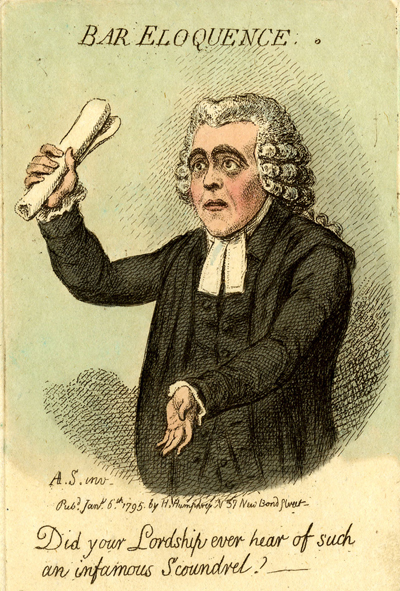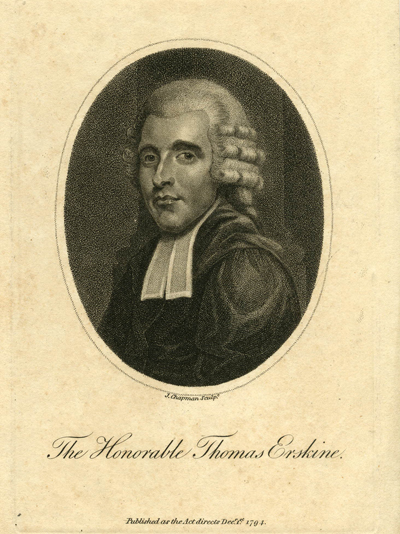Bar Eloquence
Bar Eloquence is one of a series of portrait caricatures (all listed as being published on January 6th, 1795) identifying eight kinds of eloquence, and sometimes associated with a particular, real-life individual. For more about the series as a whole, see my Overview.

© Trustees of the British Museum
Bar Eloquence is usually identified as a caricature portrait of the politician and barrister, Thomas Erskine. In 1795 Erskine was easily the most famous barrister in Britain, having made a name for himself by successully defending reformers Thomas Hardy, John Horne Tooke, and John Thelwall against charges of treason in a series of highly publicized trials in October/November 1794. As a result he was viewed as a persona non grata among Tories and a hero among Whigs and defenders of the free press. A half-length portrait of him had been printed a month before the Eloquence series and the complete transcript of the trials was already in its second edition in 1795. As one can see, there is some resemblance between the stipple and engraved portrait of Erskine by J. Chapman and the figure in Bar Eloquence. But one would be hard pressed to claim that Collings or Gillray was indebted to the Chapman image.

The Honorable Thomas Erskine [Dec. 1st, 1794]
© Trustees of the British Museum
And further, the caption/example included on the print is more typical of an expression one would expect to hear from a prosecuting, not a defense, attorney, and there is no such expression to be found anywhere in the transcripts of Erskine's defense.
The British Museum has the original drawings provided to Gillray for most of the prints in the Eloquence series, so in those cases we can see what Gillray did with his source material. But Bar Eloquence is unfortunately one of two exceptions for which there is no source sketch, so we can't tell, for instance, how closely Gillray is following Collings in this portrait. In the rest of the series, however, Gillray seems to have had little compunction about departing from Collings' source sketch. So we have to ask ouselves why, if this IS supposed to be recognizably Thomas Erskine, Gillray didn't, in this instance, produce an image closer to the Erskine in other Gillray prints?
Sources and Reading
- Commentary from the British Museum on Bar Eloquence
- "Thomas Erskine," Wikipedia
- "Samuel Collings," Wikipedia
Comments & Corrections
NOTE: Comments and/or corrections are always appreciated. To make that easier, I have included a form below that you can use. I promise never to share any of the info provided without your express permission.